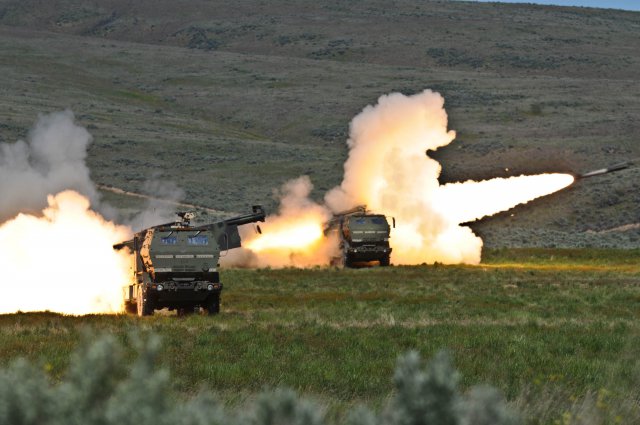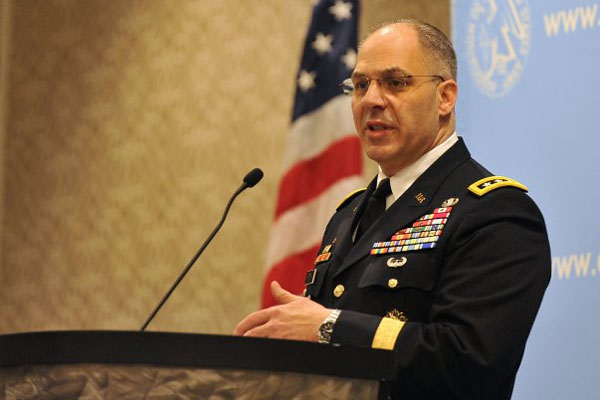
The Army will stop modernization upgrades to the HIMARS missile launcher (show here) and over 600 other programs.
AUSA: Army Futures Command has closed the books on more than 600 items of equipment that it will no longer seek to upgrade, handing responsibility for them to Army Materiel Command, service leaders said.
While many of the 600 items “transitioned to sustainment” are components, not weapons by themselves, a list the Army showed to Breaking Defense includes some big pieces of high-profile hardware. Some examples:
- the M109A6 Paladin self-propelled howitzer (but Futures Command retains control of the newest version now in production, the M109A7 PIM);
- the UH-60A and UH-60L models of the Black Hawk helicopter (but not the newest models, the 60Ms and Vs, nor the intended replacement, the Future Long-Range Assault Aircraft);
- the High Mobility Artillery Rocket System (HIMARS), a truck-mounted missile launcher (although Futures Command will keep developing new longer-range missiles);
- the A0, A1, and A2 models of the iconic Humvee (formally the High Mobility Multipurpose Wheeled Vehicle) ;
- the early Block 1 model of the Javelin anti-tank missile;
- the Secure Mobile Anti-Jam Reliable Tactical Terminal (SMART-T); and
- the ubiquitous M4 carbine (which Futures Command wants to replace with a Next Generation Squad Weapon).
Another review now underway is looking at even more programs to get rid of altogether – “transition to divestiture” – because they are either obsolete, unneeded for future conflict, or just not worth the cost of keeping around.
The reforms are the most recent aftershock of an institutional earthquake, the creation of Futures Command in August. The Army is undergoing its most radical reorganization in 40 years as it tries to urgently modernize to meet rising threats from Russia and China.

Gen. Gus Perna
“The Process Was Worthless”
Such a wholesale handover of programs is unprecedented, Gen. Gus Perna, the head of Army Materiel Command, told me in an interview. It replaces an earlier piecemeal approach that he said just didn’t work.
“The process was worthless,” Perna told me bluntly. “It was worthless.”
[Click here for our interview with Gen. Perna on the Army’s plunge into 3D printing]
For years, there was an awkward tug of war between Army bureaucracies over who managed a weapon system. In theory, the Army’s acquisition program managers developed and fielded new and upgraded equipment, while Army Materiel Command sustained existing equipment. In practice, that line was extremely difficult to draw. That problem grew bigger and bigger throughout the post-Cold War era, when the Army botched so many new programs so Reagan-era weapons had to be upgraded for decades. That meant acquisition officials kept control instead of handing them over.

Bruce Jette
“The decision nine out of 10 times was, ‘it’s not ready for transition,’” said Bruce Jette, the Army’s civilian acquisition chief, in a panel at AUSA. He and Perna worked together to develop a clear checklist to determine when a program was ready to hand over. The criteria in brief, are that “there’s no modification work orders to be done on it, there’s no Engineering Change Proposals on the table,” Jette said. “Basically, the item is done. It works. It’s in the field. We’ve got to maintain it, we may rebuild it, but we’re not doing any significant changes.”
The Army reviewed over 1,200 items. The final 600-plus to transition were decided on by Jette, Perna, and, as the final authority, Gen. John “Mike” Murray, chief of Army Futures Command.
“It’s clear, the secretary designated Gen. Murray [as] responsible for the modernization of our equipment,” Perna said. “Gen. Murray calls the ball.”

Gen. John Murray, first chief of Army Futures Command, speaks at its formal activation in Austin.
Overhauling the Army
This overhaul took concerted effort by Perna, Murray, and Jette. But, Perna told me, it’s just the latest example among many of how the three men and their organizations are working together to reallocate responsibilities and streamline the bureaucracy.
Army Futures Command was created last August by pulling together existing organizations from different parts of the Army that already worked on modernization, but in an ill-coordinated way. Training & Doctrine Command gave up its in-house futurists, while Army Materiel Command gave up its R&D arm, Research & Development Command. But, Perna argued, that change allowed AMC to focus on its core mission of sustaining the current force with spare parts and other supplies while the new Futures Command focuses on, well, the force of the future.
RDECOM had lots of engineers who work on current Army programs, not just scientists developing future tech, Perna told me. “I probably could have presented a very good argument that said….’they do work that I need in my role as the fleet manager of sustainment,’” he said. “[But] my personal opinion as a senior army leader was that it was more important for army Futures Command to be the command responsible for everything modernization and in that light, it was my recommendation to give REDCOM to Futures Command.”
A subsequent reorganization actually boosted AMC. It took over the formerly independent Installation Management Command (IMCOM), which runs Army bases worldwide. That fits with AMC’s new laser focus on sustaining every aspect of the current force, Perna said. Indeed, IMCOM had already redefined its mission in terms of supporting military readiness. What’s more, the Army’s evolving concept for future conflict speaks of bases, not as safe havens for troops and families, but as the “strategic support area,” a critical component of the service’s capacity to project power overseas, a component already under target for cyber attack and, potentially, for physical attack as well.
The new Army Secretary, Ryan McCarthy, and the new Chief of Staff, Gen. James McConville, “both of them have told me to be responsible for the logistics, sustainment, and material readiness of the Army at the strategic level and to assume responsibility for the strategic support area underneath multi-domain operations,” Perna told me “That’s the reason why Installation Management Command has moved underneath us. They were a direct reporting unit to the Chief of Staff of the Army; now they report to me.”
Read more about AMC’s new role in the extended excerpts from our interview with Gen. Perna, below.

Gen. Gustave Perna
A Professional Talks Logistics
Breaking Defense: The Army is transitioning some 600 programs to sustainment. That’s a pretty big deal.
Gen. Perna: It was. It was some herculean work. But I would pass my accolades to those two leaders, Gen. Murray and Dr Jette.
The three of us came together. The secretary designated Gen. Murray as the decision maker. And then it was our teams working to determine the 600-plus programs that we were going to transition to sustainment. Huge deal.
But I would also add the transition to divestiture. What are we going to eliminate so that we can continue to modernize ourselves as we evolve? There’s just some things that need to go away, in order to move forward.
BD: The old process – where transitions kept getting postponed – sounds like it was more about avoiding decisions than making them.
Perna: It was worthless. The process was worthless.
It’s criteria based now. It’s brought through the decision cycle up through Dr. Jette, myself, and Gen. Murray, and Gen. Murray calls the ball. There’s no MOU [Memorandum of Understanding]. It’s clear, the secretary designated General Murray as responsible for the modernization of our equipment.
And if something happens, if two years from now, Murray says, “All right, we weren’t able to get to our next goal, we’re going to have to go to the next level of [an item that already transitioned to sustainment],” it transitions back to Dr Jette.
BD: So you can restart incremental modernization if you need to.
Perna: Yes. But that’s not where we really want to be. We want to focus on modernization. We want to drive ourselves for future requirements.
My role is the supply chain requirements, making sure that we maintain a safe capable product, to make sure that it’s still executing the way we want. It just doesn’t need to be developed to the next level anymore.
And I have authority to bring it back to General Murray to divest it. Do you really want me to try to maintain this for X more years at this cost, or can you expedite the replacement?
BD: You transitioned 600 items to sustainment – do you know how many will get transitioned to divestiture?
Perna: What we’ve done, we’ve gone through all the programs, and we know where they stand against the criteria. And if all the criteria are met, then it gets presented to the three of us for decision — it’s not on automatic.
Dr Jette is not empowered to say no. Only Mike Murray is.
My staffs are tracking what they think the years of when things will meet all the criteria [in the future]. So we have a game plan for where we’re going.
Click below to read Part I of this interview:
Sullivan says Ukraine supplemental should cover all of 2024, long-range ATACMS now in Ukraine
“We now have a significant number of ATACMS coming off their production line and entering US stocks,” Jake Sullivan said today. “And as a result, we can move forward with providing the ATACMS while also sustaining the readiness of the US armed forces.”


























